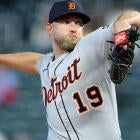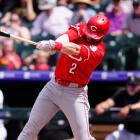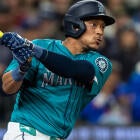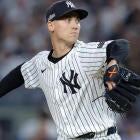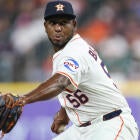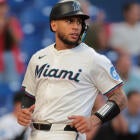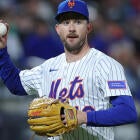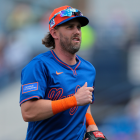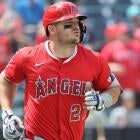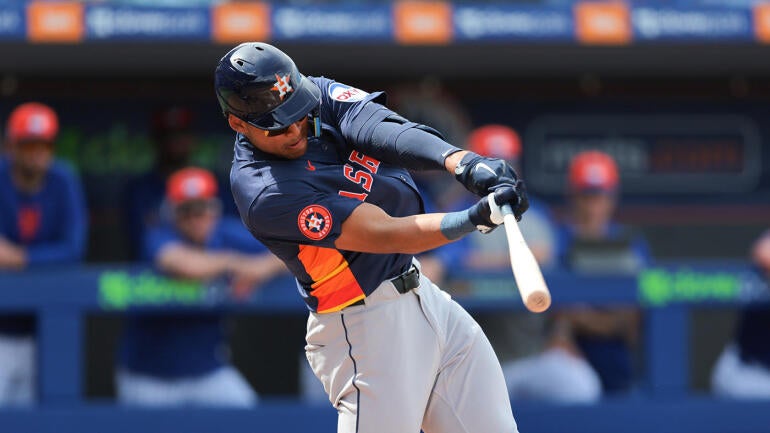
I've had a theory about Fantasy Baseball for a while: That ADP becomes less predictive of performance in the upcoming season the closer you get to Opening Day.
Now, this is a theory that, in many ways, I know isn't true. Drafts that happened in February of this season would have seen Gerritt Cole go off the board as a top-15 starting pitcher, which is obviously going to be much less accurate than drafts that happened after we knew he was out for the season. Injuries are one way this theory falls apart, and we also obviously know more about roles the closer we get to Opening Day, which will make those later drafts more accurate.
But, when we take out players whose price changed primarily because of injuries or role changes, I think there's something to this theory. Because most of the time a player's price changes as we get closer to the season, it's because of something we're seeing in Spring Training or something we're hearing from beatwriters. Which is to say, for pretty flimsy reasons.
It's too early in the 2025 season to test this theory, but I did want to check in on how the early-season risers are doing. Was the hype worth it? Or would you have been better off fading the biggest risers in price?
I've compared every player's price from the final week before Opening Day to all drafts before that to identify the 10 biggest risers in ADP, so let's take a look at whether the hype looks like it was worth it. I'll be revisiting this topic over the next couple of months, so let's get a way-too-early look here:
Cam Smith, 3B, HOU
Pre-March 21 ADP:560.4; Post-March 21: 256.77
This was one of the more justifiable late-spring risers because Smith went from basically entirely off Fantasy radars to being worth drafting in all leagues after it became clear he would make the Astros roster. Of course, we're seeing the adjustment period required to make the leap from barely playing at Double-A to the majors, as Smith has struck out in 43% of his plate appearances while already losing playing time. I think there's a real risk Smith gets sent back to the minors pretty soon, but I will maintain that it was reasonable to take a flier on him outside the top 200 just in case the Astros' bet on him worked out. It still may.
Victor Scott II, OF, STL
Pre-March 21 ADP:431.3; Post-March 21: 253.53
Another one whose price spiked only after it became clear he would make the roster, which is perfectly reasonable. And it's worked out a lot better than it did last season when Scott made the leap to the majors and floundered. So far this time, he's hitting .281/.368/.406 with four steals in nine games, and while his strikeout rate (23.7%) is a bit higher than you'd want for someone with limited power, he's actually making an above-average rate of contact when he swings, so it's not exactly a red flag. He's swinging at more pitches in the zone and chasing less than he did last season, which is exactly what we want to see. Scott looks like he has a much better chance of sticking this time around.
Spencer Strider, P, ATL
Pre-March 21 ADP:122.37; Post-March 21: 77.11
A 45-pick jump, based mostly on two spring outings. On the one hand, it makes sense – he struck out 10 batters over 4 innings of work, which served as proof that the stuff still worked. And the start of his minor-league rehab assignment has confirmed that, as Strider has struck out 14 of the 30 hitters he has faced over 8.1 innings with Triple-A Gwinnett, too. Maybe that's all that matters.
But I will just note that, while the results have been overwhelming, Strider's stuff isn't all the way back to his pre-injury form. In his most recent start at Triple-A, his fastball averaged 95.9 mph, down 1.3 mph from the last time we saw him healthy in 2023. Again, it may not matter – the results certainly suggest it won't. But when you account for the fact that Strider will likely have to face some limitations when he returns, his price started to get pushed to a point that left very little margin for error for his performance. Dominating minor-leaguers and spring lineups may not be the same thing as getting major-leaguers out. I expect Strider to be very good, I'm just not quite as convinced he'll be as dominant as everyone else.
Aroldis Chapman, P, BOS
Pre-March 21 ADP:328.08; Post-March 21: 214.32
This one is simple enough: Chapman was announced as the Red Sox closer just before the season, something we weren't sure of at the start of spring. He's not such a dominant reliever that Chapman would be must-roster if he was in a closer committee, but he's certainly good enough to be a must-roster pitcher if he's the named closer. This one makes perfect sense.
Clay Holmes, P, NYM
Pre-March 21 ADP:256.5; Post-March 21: 170.75
This is probably the best example of Spring Training stats-induced hysteria. Holmes showed up this spring with an expanded arsenal, adding a four-seamer, changeup, and cutter to his sinker/sweeper/slider mix with the hopes of being able to both neutralize the platoon advantage lefties have had on him and to pitch effectively deeper into games. That his new changeup was of the kick-change variety meant he also got swept up in a concurrent hype stream that took over the baseball world – the kick-change is a clever bit of branding for a different grip on the circle-change that should allow pitchers who otherwise struggle to throw a changeup to add one to their arsenal, though obviously there are no guarantees that pitch will be a difference maker for everyone.
It's only three starts, and Holmes did look much better than his final line in his third especially. But on the whole, Holmes hasn't looked great as a starter so far. He barely leaned on his expanded arsenal in his first start, and things weren't much better when he did in his second. The command has been pretty bad on the whole and he didn't make it out of the fifth inning until his third start when he kind of ran out of steam in the sixth. That's not to say he can't be a useful Fantasy option moving forward, but I do think folks got out over their skis on him as a potential ace this spring, with his price pushing close to the top 150 in some drafts. I moved him up this spring too, mind you, but he remained outside of the top 200 for me, and I feel good about that.
Dustin May, P, LAD
Pre-March 21 ADP:400.49; Post-March 21: 270.97
Here's another one where the role was uncertain and then it wasn't, which explains most of the rise here. But I will also note that I think there's probably been some upside ascribed to May that just may not be there. He looks great when you watch him – his stuff sizzles, and it looks like he should be overpowering. But he's always been more of a Sandy Alcantara-type, only without the projectable volume that has made Alcantara such a standout. May has a 22.2% strikeout rate for his career and hasn't been racking up strikeouts in the early going this season. He can still be a very useful Fantasy option, there just probably isn't as much upside here as you might think.
Cristopher Sanchez, P, PHI
Pre-March 21 ADP:173.86; Post-March 21: 127.47
I was okay with Sanchez's price rising because I viewed it as more of a market correction – Sanchez was being weirdly undervalued even before his velocity jump this spring. He had a 3.32 ERA last season, after all. The velocity jump added some hype to the profile, hype he has so far lived up to, with 13 strikeouts in his first 11 innings of work. This is a solid, high-floor profile who might have unlocked some unexpected upside, and that's a profile worth betting on – he reminds a little bit of Alcantara before his Cy Young season, actually, and Sanchez actually has the skills and lack of injury history to project a real workhorse workload onto him.
Gavin Williams, P, CLE
Pre-March 21 ADP:224.92; Post-March 21: 165.07
Williams looked healthy and was throwing harder than ever this spring, sitting 97-99 comfortably and blowing hitters away. But this might be a case of buying too much into the production, even with the improved velocity. He was mostly just pumping fastballs by hitters this spring, and that hasn't worked in his first two starts – and for some reason, Williams has gone back to just being a three-pitch pitcher. Forced by necessity to expand his arsenal after coming back from a sprained elbow last season, Williams started throwing both a cutter and a harder slider, but he's back to just being a fastball/sweeper/curveball guy these days. No changeups so far, even! It can work, but he needs the fastball to be dominant if he's throwing it 70% of the time, and it hasn't been yet. There's clearly talent here, but there's also significant performance risk and the inherent risk that comes from a velocity jump after an elbow injury. I wasn't buying Williams at his increased price, and while I'm not dropping him if I have him, I would need a buy-low opportunity to trade for him.
Robbie Ray, P, SF
Pre-March 21 ADP:160.06; Post-March 21: 120.23
Ray got caught up in some of the Ray hype this spring, though not necessarily because of his results – it was mostly just a reminder that, when healthy, Ray tends to be really good. He hasn't been so far, but the way he has struggled has been with a lack of strikeouts, which is never really a concern for Ray – and isn't really a concern for me right now. His new changeup is definitely a work in progress, but I still trust the rest of the arsenal enough to generate the kind of whiffs we need from him, and I do think Ray should be a very good pitcher moving forward. The one concern I have is a bit of a velocity drop, though he's still around the level he was at in 2022 when he had 212 strikeouts and a 3.71 ERA, so I'm certainly not panicking.
Kristian Campbell, 2B, BOS
Pre-March 21 ADP:297.24; Post-March 21: 237.78
This is one where the spring production probably helped keep Campbell's price in check, because if he had been raking all along, he might have gotten pushed into the top 150 by the end of draft season. Instead, Campbell's price remained totally reasonable despite the fact that he's a top prospect who had a clear path to an Opening Day job all along. He hit .167/.305/.271 with a 30.5% strikeout rate, which some read as a sign that he just wasn't ready and wouldn't get the chance.
But the Red Sox never really wavered in their belief that Campbell was going to be their starting second baseman, and he rewarded their confidence with a huge first 10 games. Maybe it won't last, but he sure looks the part, and the fact that the Red Sox never lost confidence in him mattered more to me than the numbers over 59 games in the Grapefruit League. It's working out well so far, and Campbell has even made a couple of appearances in the outfield, putting him three appearances away from multi-eligibility. That would be huge.
![[object Object] Logo](https://sportshub.cbsistatic.com/i/2020/04/22/e9ceb731-8b3f-4c60-98fe-090ab66a2997/screen-shot-2020-04-22-at-11-04-56-am.png)








